
German postcard by Photochemie, Berlin, no. K. 220. Photo: A. Binder, Berlin.

German postcard by Rotophot in the Film Sterne series, no. 529/2. Photo: Richard Oswald-Film. Erna Morena in Das Tagebuch einer Verlorenen/The Diary of a Lost Woman (Richard Oswald, 1918).

German postcard by Ross Verlag, Berlin, no. 616/2. Photo: Richard-Oswald-Film. Reinhold Schünzel and Ilka Grüning in Die sich verkaufen, part 2 of the series Prostitution (Richard Oswald, 1919).
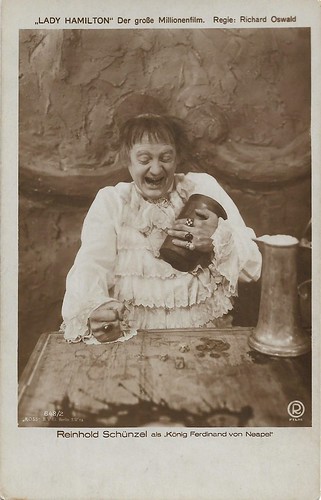
German postcard by Ross Verlag, Berlin, no. 648/2. Photo: Richard Oswald-Film. Reinhold Schünzel as King Ferdinand IV of Naples in Lady Hamilton (Richard Oswald, 1921). Caption: The big millions film.
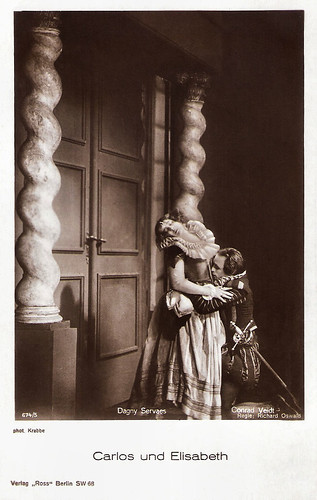
German postcard by Ross Verlag, Berlin, no. 674/5. Photo: Krabbe / Richard-Oswald-Film. Dagny Servaes and Conrad Veidt in Carlos und Elisabeth/Carlos and Elisabeth (Richard Oswald, 1924).
He tried his hand at almost every genre
Richard Oswald was born Richard W. Ornstein in 1880 in Vienna, Austria-Hungary, now Austria. His father was Alois Ornstein, a wealthy merchant and devout Jew, and his mother was his wife Fanny, née Bruck. Oswald studied at the Wiener Dramatischen Hochschule (Vienna Dramatic Academy) from 1896. He took his stage name from a character in Henrik Ibsen's play 'Ghosts'.
He began his career as a stage actor and stagehand at Süddeutschen Novitäten-Ensemble (South German Novelty Ensemble) in Berchtesgaden in 1899. He moved to Znaim (Znojmo) the following year. There, Oswald met his colleague Bernd Aldor, whom he was later to bring before the camera several times with leading roles during the First World War. Via Preßburg he moved to the Vienna Raimund Theater in 1907, and in 1909 to the Theater in der Josefstadt, where he also worked as a dramaturge and director. After anti-Semitic hostility, he went to work as an actor at the Düsseldorf Schauspielhaus in 1910. Here he met the actress Käte Waldeck and married her in Berlin in 1913. There their daughter Ruth was born as their first child. He made his film debut as an actor in Halbwelt/Demimonde (Reinhard Bruck, 1911) and Zouza (Reinhard Bruck, 1911) with the French star Polaire in the title role as a Cuban singer. Oswald didn't want to be a film actor and his film acting career stopped soon.
His childhood friend Hermann Fellner hired him in 1914 as a dramaturge and advertising expert for the film company Deutsche Vitascope GmbH, which merged with the projection company "Union" (PAGU) shortly afterwards. With his third screenplay, an adaptation of Arthur Conan Doyle's 'The Hound of the Baskervilles', Der Hund von Baskerville (Rudolf Meinert, 1914), Oswald established himself as an author of crowd-pleasing material. The film starring Alwin Neuss as Sherlock Holmes was a huge success. From the outbreak of the First World War, Oswald, who was unfit for military service, was also given the chance to direct films himself. At age 34, Oswald's first film as a director was Ivan Koschula (Richard Oswald, 1914). He then made Das eiserne Kreuz/The Iron Cross (Richard Oswald, 1914) starring Friedrich Kühne, Hedda Vernon, and Hanni Weisse. (Some sources say this was his directorial debut). Despite its patriotic name, the film was seized by the German authorities and all its copies were destroyed due to the film's pacifist nature. The film was shot for Vitascope at the Tempelhof Studios in Berlin.
Oswald worked several times for producers Jules Greenbaum and Paul Davidson at the PAGU. Their Lache Bajazzo/Laugh Bajazzo (Richard Oswald, 1915) is a silent drama film starring Rudolph Schildkraut, Alfred Abel and Hanni Weisse. It was shot at the Weissensee Studios in Berlin. In 1915 he joined the newly founded Greenbaum-Film GmbH as head director and writer, where he continued the Baskerville series. Oswald created the German detective Engelbert Fox for Lothar Stark and directed the film debut of Werner Krauß with Hoffmanns Erzählungen/Tales of Hoffmann (Richard Oswald, 1916) starring Kurt Wolowsky and Erich Kaiser-Titz as the young and older author E.T.A. Hoffmann.
In 1916, Oswald founded his own production company in Berlin, Richard Oswald-Film GmbH, writing and directing most of his films himself. He tried his hand at almost every genre. Oswald worked together with Werner Krauß, Lupu Pick and Reinhold Schünzel and discovered Lya de Putti and Conrad Veidt for the film. His early productions included horror films such as Nächte des Grauens/A Night of Horror (Richard Oswald, Arthur Robison, 1916) starring Werner Krauss and Emil Jannings. It is the earliest known feature-length film to portray vampires, with vampire-like people appearing in the film.

German postcard by Hermann Leiser Verlag, Berlin, no. 3152. Photo: Richard-Oswald-Produktion. Bernd Aldor in Das Bildnis des Dorian Gray/The Picture of Dorian Gray (Richard Oswald, 1917).
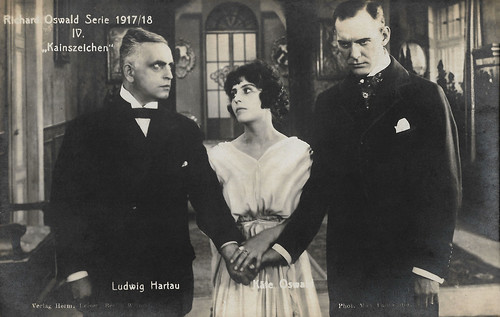
German postcard by Verlag Hermann Leiser, Berlin. Photo: Max Fassbender / Richard Oswald-Film. Käthe Oswald and Ludwig Hartau in Kainszeichen/The Mark of Cain (Richard Oswald, 1917). Caption: Richard Oswald series 1917-18, IV. The man on the right could be Alexander von Antalffy.

German postcard by Rotophot in the Film Sterne series, no. 529/6. Photo: Richard Oswald-Film. Erna Morena, Conrad Veidt (at right) and Reinhold Schünzel in Das Tagebuch einer Verlorenen/The Diary of a Lost Woman (Richard Oswald, 1918).

German postcard by Rotophot. in the Film Sterne series, no. 550/4. Photo: Richard Oswald Film Ges., Berlin. Publicity still for Jettchen Geberts Geschichte/Jettchen Gebert's Story/Jettchen Gebert/ Henriette Jacoby (Richard Oswald, 1918), starring Mechtildis Thein as the title character and Conrad Veidt as her beloved. The two other men are Max Gülstorff (sitting) as Uncle Eli and Leo Connard as Jettchen's father, Salomon Gebert.

German postcard in the Film Sterne series by Rotophot, no. 563/6. Photo: Richard-Oswald-Film. Anita Berber and Julius Spielmann in Das Dreimäderlhaus/The House of Three Girls (Richard Oswald, 1918), considered a lost film and dealing with the life of composer Franz Schubert (Julius Spielmann, the man with spectacles at the right).
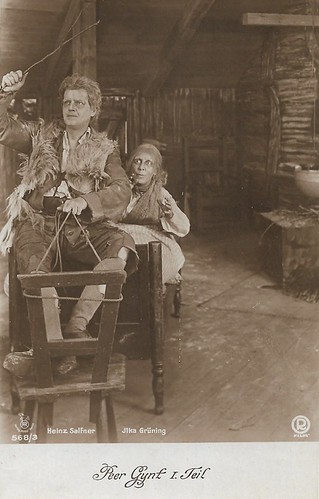
German postcard in the Film-Sterne series by Rotophot, no. 568/3. Photo: Richard Oswald-Film. Heinz Salfner as Peer Gynt and Ilka Grüning as his mother Aase in Peer Gynt (Victor Barnowsky, Richard Oswald, 1918-1919). This was a two-part film, shot and passing the German censor in 1918, but the first public release in Berlin was in April 1919. The film was an adaptation of Henrik Ibsen's dramatic poem (1867). It was the only film by theatre expert Barnowsky, who also scripted the film. The cinematography was by Max Fassbender.
Taboo subjects and punishable acts
Immediately after the end of the First World War, Richard Oswald began to build up a film company. In January 1919 he founded the Richard Oswald Filmverleih and in July acquired the Prinzeß-Theater at Kantstraße 163 in Berlin, which he continued till 1926 to run as the Richard-Oswald-Lichtspiele. He is considered the founder of the so-called 'Aufklärungsfilme'(enlightenment films). With the participation of the sex researcher Magnus Hirschfeld, he devoted himself towards the end of the First World War to taboo subjects and punishable acts in Es werde Licht!/Let There Be Light, a four-part film cycle by Oswald shot from 1916 to 1918. The films were a protest against Germany's anti-abortion law and also touched on the dangers of syphilis and other venereal diseases. Es werde Licht! is considered the forefather of all sex education films. The leading roles are played by Bernd Aldor (parts 1 and 2), Theodor Loos (parts 2 and 3), Werner Krauß (part 3), Conrad Veidt (part 4) and Reinhold Schünzel (part 4).
Filmed during this "censorship-free" period, the 'Aufklärungsfilme' sparked a fierce debate about the reintroduction of compulsory censorship. Among his other Aufklärungsfilme are Das Tagebuch einer Verlorenen/The Diary of a Lost Woman (Richard Oswald, 1918) with Erna Morena and the sadomasochistic case study Dida Ibsens Geschichte/Dida Ibsen's Story (Richard Oswald, 1918), starring Oswald's star Anita Berber. The most high-profile of these films was Anders als die Andern/Different from the Others (Richard Oswald, 1919) starring Conrad Veidt and Reinhold Schünzel. The film was intended as a polemic against the then-current laws under Germany's Paragraph 175, which made homosexuality a criminal offence. Anders als die Andern is one of the first sympathetic portrayals of homosexuals in cinema. Censorship laws were enacted in reaction to films like Anders als die Andern and by October 1920 only doctors and medical researchers could view it. Prints of the film were among the many "decadent" works burned by the Nazis after they came to power in 1933.
His other pre-1920 efforts include such literary adaptations as Das Bildnis des Dorian Gray/The Picture of Dorian Gray (Richard Oswald, 1917) starring Bernd Aldor, Ernst Pittschau, and Ernst Ludwig and based on the 1890 novel 'The Picture of Dorian Gray' by Oscar Wilde, Peer Gynt (Victor Barnowsky, Richard Oswald, 1919) starring Heinz Salfner and Ilka Grüning and based upon the play by Henrik Ibsen, and Die Reise um die Erde in 80 Tagen/Around the World in Eighty Days (Richard Oswald, 1919) starring Conrad Veidt as Phileas Fogg, Anita Berber, and Reinhold Schünzel and based on the Jules Verne novel 'Around the World in Eighty Days' (1873).
The 1920s became Richard Oswald's most productive, creative and successful period in Germany. In 1921 he founded the Richard Oswald Film AG, of which he was a member of the board alongside Heinz Ullstein and the businessman Alexander Engel. Oswald directed a series of historical films. Lady Hamilton (Richard Oswald, 1921) starring Liane Haid and Conrad Veidt, depicts the love affair between the British Admiral Lord Nelson and Lady Emma Hamilton. It was based on two novels by Heinrich Vollrath Schumacher. It was successfully distributed abroad. Another hit was Lucrezia Borgia (Richard Oswald, 1922) again starring Conrad Veidt and Liane Haid, which portrayed the life of the Renaissance Italian aristocrat Lucrezia Borgia (1480–1519). Carlos und Elisabeth/Carlos and Elisabeth (Richard Oswald, 1924) starring Conrad Veidt, Eugen Klöpfer, and Dagny Servaes was based on the play 'Don Carlos' by Friedrich Schiller. Oswald modelled the film's visuals on Max Reinhardt's staging of the play at the Deutsches Theater.
When Carlos und Elisabeth (1924) was a failure at the box office, Oswald turned back to genre films, which were less costly financially. He directed such comedies as Lumpen und Seide/Rags and Silk (Richard Oswald, 1925) starring Reinhold Schünzel and Mary Parker and he made a significant number of Operetta films during his later career. A silent example is Im weißen Rößl/The White Horse Inn (Richard Oswald, 1926) starring Liane Haid and Max Hansen, and based on the play 'Im weißen Rößl by Oskar Blumenthal and Gustav Kadelburg. Richard Oswald Film-AG had to file for bankruptcy in 1926. Oswald continued to work tirelessly under various new company names in the following years, including for Nero Film, which he founded together with Heinrich Nebenzahl. Oswald took up politically explosive themes with Feme/Assassination (Richard Oswald, 1927), a film about the assassination of politician Walter Rathenau and made the historical drama Cagliostro (Richard Oswald, 1929) an international coproduction starring Hans Stüwe and Renée Héribel, which depicts the life of the eighteenth-century Italian occultist Alessandro Cagliostro.

Belgian postcard by Société Gama-Film, Brussels. Photo: Richard Oswald Film. Publicity still for Lady Hamilton (Richard Oswald, 1921).

German postcard. Photo: Richard Oswald Film. Conrad Veidt in Lucrezia Borgia (Richard Oswald, 1922).

German postcard by Ross Verlag, Berlin, no. 674/1. Photo: Krabbe. Dagny Servaes as Elisabeth of Valois, wife of Philip II and Queen of Spain, in Carlos und Elisabeth/Carlos and Elisabeth (Richard Oswald, 1924).

German postcard. Photo: Westi, Berlin. Mary Kid and Ferdinand Bonn in Lumpen und Seide/Rags and Silk (Richard Oswald, 1925).

German postcard by Ross Verlag, no. 4006/1, 1929-1930. Hans Stüwe in Cagliostro (Richard Oswald, 1929).
Rising anti-semitism and impending danger
Richard Oswald survived the transition to sound with one of his greatest successes, the Operetta Wien, du Stadt der Lieder/Vienna, City of Songs (Richard Oswald, 1930). Breaking with the then-popular wine, women and song genre by filling most of the main roles with leading stars from Berlin's cabaret scene including Paul Morgan, Max Hansen, Siegfried (Sig) Arno, Max Ehrlich and Paul Graetz, the film immediately met with enormous public acclaim. Oswald directed the Science-Fiction Horror film Alraune/Mandrake (Richard Oswald, 1930) with Brigitte Helm in the role of Alraune. Gabriel Pascal also produced the comedy Der Hauptmann von Köpenick/The Captain from Köpenick (Richard Oswald, 1931), one of several films based on the play by Carl Zuckmayer which centres on the Hauptmann von Köpenick affair in 1906. Soon followed Viktoria und ihr Husar/Victoria and Her Hussar (Richard Oswald, 1931) and Gräfin Mariza/Countess Mariza (Richard Oswald, 1932) starring Dorothea Wieck. Unheimliche Geschichten/Unholy Tales (Richard Oswald, 1932) was based on stories by Edgar Allan Poe and Robert Louis Stevenson and produced by Gabriel Pascal. Paul Wegener starred as a crazed scientist who murders his wife. Hal Erickson writes at All Movie: "Some critics have suggested that Oswald was more prolific than talented, but such films as his 1932 horror omnibus Unholy Tales would seem to refute this statement."
After the Nazi takeover, Propaganda Minister Joseph Goebbels attended the premiere of Ein Lied geht um die Welt/My Song Goes Round the World (Richard Oswald, 1933) in May 1933, in which the popular (Jewish) tenor Joseph Schmidt played a leading role. However, Oswald's previously launched Ganovenehre/Crook's Honor (Richard Oswald, 1932) was among the first feature films to be banned by the Nazi censors. Ein Lied geht um Welt was Oswald's last film produced in Germany before he recognised the rising anti-semitism and impending danger. Being Jewish, Oswald fled Nazi Germany in 1933 and returned to Austria with his wife and their two children. In the Netherlands, he made the successful film tragi-comedy Bleeke Bet/Bleak Beth (Alex Benno, Richard Oswald, 1934) starring Aaf Bouber, Fien de la Mar and Johannes Heesters. His collaboration on Bleeke Bet eventually led to some commotion. Oswald felt that assistant director Alex Benno claimed too much credit for the film, to which Benno replied that he was not impressed by Oswald's directorial qualities. Benno wondered aloud whether someone who was only in the Netherlands for a short time could gain enough insight into Dutch nature to make a good Dutch feature film.
Oswald left Austria as it became an increasingly hostile working environment in the years leading up to the Anschluss. In France, he directed the drama Tempête sur l'Asie/Storm over Asia (Richard Oswald, 1938) starring Conrad Veidt, Sessue Hayakawa and Madeleine Robinson. It was Oswald's last film in Europe. He emigrated to the United States. He made three films in Hollywood, including an American version of 'Der Hauptmann von Köpenick', I Was a Criminal (Richard Oswald, 1945), also known as Passport to Heaven. In his biography of Oswald in 'Das große Personenlexikon des Films', Kay Weniger recalled Oswald's problems with shooting good films in Hollywood: "Of all his films, only his barely screened I Was a Criminal, with an excellent performance by Albert Bassermann in the leading role, is of any relevance. As U.S. audiences had a hard time relating to themes of Prussian militarism, subservience and lack of democracy, the film went without a distributor for many years and only premiered at the beginning of 1945".
Jan Christopher Horak added in 'Exilfilm, 1933–1945': "Completely forgotten is the film version of Carl Zuckmayer's 'Der Captain of Köpenick', Passport to Heaven (1941) (...). Yet the film is a remarkable achievement of the director. The architecture of Berlin is composed of documentary shots and studio buildings, and the camera work uses light and shadow to bring the symbols of power into the picture again and again: In one shot, the ubiquitous image of the Kaiser is transformed by shadows into a portrait of the Führer. (...) Unlike Max Adalbert (1931) and Heinz Rühmann (1956), who played the cobbler as a "little man", Albert Bassermann, despite a strong linguistic accent, is rebellious, defiant and angry, always questioning state power with the consciousness of someone exiled by the Nazis: a ravishing portrayal that makes the film perhaps the most German of all exile films."
Richard Oswald's last production was The Lovable Cheat (Richard Oswald, 1949), an inexpensive but worthwhile adaptation of an Honoré de Balzac story which boasted an impressive cast including Charles Ruggles, Curt Bois, and Buster Keaton. With his company Richard Oswald TV Productions, he made one last attempt to realise films in 1951. However, the television series Destiny, planned for over a hundred episodes, was already stopped after the 30-minute pilot The Mayerling Story (Richard Oswald, 1951) with Dan O'Herlihy. In 1962 Oswald visited his relatives in Düsseldorf and went on to Rome to visit his son, director and producer Gerd Oswald, who was shooting a film there. In Rome, he fell seriously ill and returned to Düsseldorf with his wife. Richard Oswald died in Düsseldorf in 1963. He was 82. In 1990, Hans-Michael Beck, Wolfgang Jacobsen, and Jorg Schoening wrote the excellent biography 'Richard Oswald'.
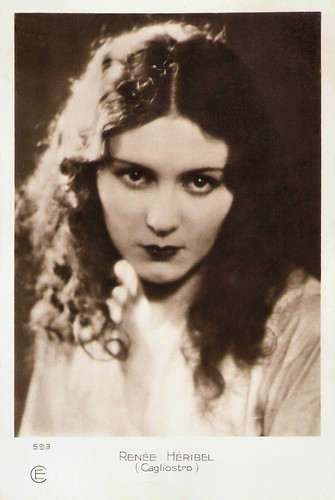
French postcard by Cinémagazine-Edition, no. 593. Renée Heribel as Lorenza in the Franco-German co-production Cagliostro (Richard Oswald, 1929).

German postcard by Ross Verlag, no. 5501/2. Distributed in Italy by Ballerini & Frattini, Florence. Photo: Ufa. Brigitte Helm in Alraune (Richard Oswald, 1930).
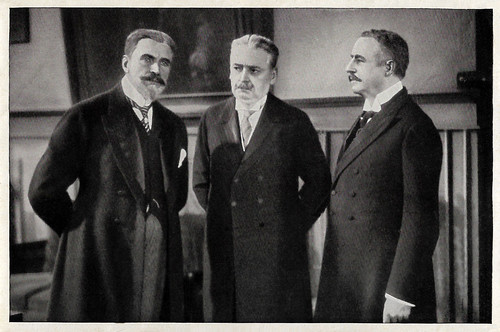
German collectors card in the series 'Vom Werden deutscher Filmkunst - Der Tonfilm', album no. 11, picture no. 118. Photo: Richard Oswald-Film / Ross Verlag. Albert Bassermann in 1914, die letzten Tage vor dem Weltbrand/1914: The Last Days Before the War (Richard Oswald, 1931). The film triggered a censorship scandal.

German postcard by Ross Verlag, no. 148/1. Photo: K. Ewald / Oswald-Film /SF (Sud Film AG). Paul Wegener as the murderer, Eugen Klöpfer as the principal physician and Maria Koppenhöfer as Her Highness in Unheimliche Geschichten/Uncanny Stories (Richard Oswald, 1932).
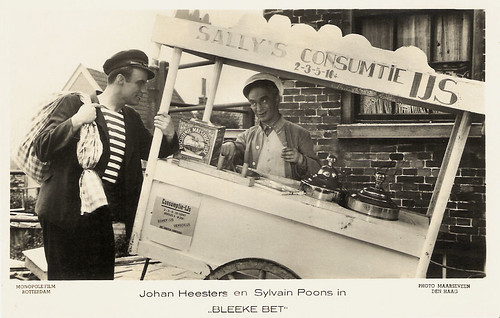
Dutch postcard by Monopole Film, Amsterdam. Photo: Maarseveen, Den Haag. Sylvain Poons and Johannes Heesters in the Dutch tragicomedy Bleeke Bet/Bleak Beth (Richard Oswald, Alex Benno, 1934). Collection: Geoffrey Donaldson Institute.
Sources: Jan Christopher Horak (Exilfilm, 1933–1945 - German), Hal Erickson (AllMovie), Doug Sederberg (IMDb), Eye (Dutch), Wikipedia (English, German and French), and IMDb.
No comments:
Post a Comment